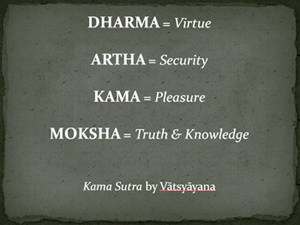
"Kama Sutra" is comprised of seven parts, with thirty-six
chapters, a preface, introduction and appendix. The seven parts
include:
- Salutation to Dharma, Artha and Kama
- On Sexual Union
- About the Acquisition of a Wife
- About a Wife
- About the Wives of Other People
- About Courtesans
- On the Means of Attracting Others to One's
Self
The most well-known English edition of the book was translated in
1883 from the Sanskrit by Sir Richard Francis Burton in
collaboration with Forster Fitzgerald Arbuthnot and Shivaram Parashuram Bhide. The version used
for this review also contained translations by Bhagavanlal
Indrajit.

The English translation of "Kama Sutra" is well-written, an easy
read which maintains a smooth flow from start to finish.
Four terms used in "Kama Sutra" (describing the
various stages of life) come from the "Laws of Manu." They are
defined as follows:
Dharma (gaining religious merit; re: virtue), Artha
(acquiring wealth and property; re: security), Kama
(love and sensual gratification; re: pleasure), and Moksha
(liberation from the cycle of re-birth; re: truth and knowledge).

The sexual (Kama) content in the book is provocative,
without a doubt. However, the various sexual positions and their
descriptions are conveyed in clear, almost clinical terms. At the
same time, the reader is made to feel the detailed graphics and
explanations are completely natural, part of the basic human
desire to strive for and achieve mutual sexual pleasure.
Some of the points include different forms of kissing
(nominal, bent, straight, turned, throbbing, touching);
embracing (touching, piercing, rubbing,
pressing); marking with nails (half-moon,
circle, tigers nail or claw), biting (hidden,
swollen, line of jewels); laying down (also
known as congress, such as widely opened, yawning, half-pressed,
splitting of a bamboo, lotus-like); mouth congress
(oral sex), striking (on special
places on the body with passion, i.e. shoulders, middle, sides),
and the sexual act itself (according to
dimensions or force of desire).
The seven types of "congress" are loving (following
a quarrel or long separation), subsequent (new
love), artificial (two people who belong
to others), transferred (fantasizing of
another during the union), eunuchs (with
a person of lesser class), deceitful (with
a courtesan) and spontaneous (between
two people who love each other).
While the general focus in my specific edition of "Kama Sutra"
was on the sexual aspects of
human evolvement, the book also gives nod to the other facets that
are meant to take one on a journey of inclusive
self-discovery.
For example, Dharma ("cosmic law and order") can be attained by
keeping to the tenets of one's religious beliefs. In essence,
Dharma is striving for virtue and doing no harm to others.
Artha (purpose of life or security) reflects the desire
to obtain economic stability. And finally Moksha
is a self-realization of sorts, an understanding and liberation
from the human cycle of death and re-birth by acquiring the
knowledge to do so. Achieving a harmonious balance in the stages
of life is important to all human beings.
To conclude, "Kama Sutra" describes the various stages of life
in easy to understand terms. The writing (or the English
translation thereof) links one chapter to the next with a natural
flow, and is nearly flawless in its enactment and interpretations.
As Vātsyāyana reflected:
A person acquainted with the
true principles of this science, who preserves his Dharma, his
Artha and his Kama, and who has regard to the customs of the
people, is sure to obtain the mastery over his senses. In short,
an intelligent and knowing person attending to Dharma and Artha
and also to Kama, without becoming the slave of his passions, will
obtain success in everything that he may do.

 From
Ken Davies: Awesome review. The book is widely seen
as "taboo" by people who have never held a copy in their lives.
Your review does two things for me: accurately describes the
content, and encourages people to keep their minds open to things
they may not know about. Good job!
From
Ken Davies: Awesome review. The book is widely seen
as "taboo" by people who have never held a copy in their lives.
Your review does two things for me: accurately describes the
content, and encourages people to keep their minds open to things
they may not know about. Good job!
Click here to send comments or questions.

